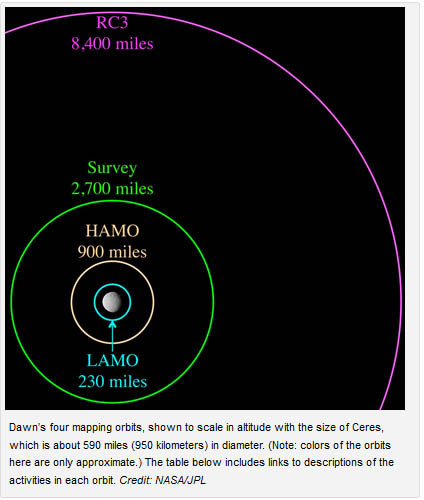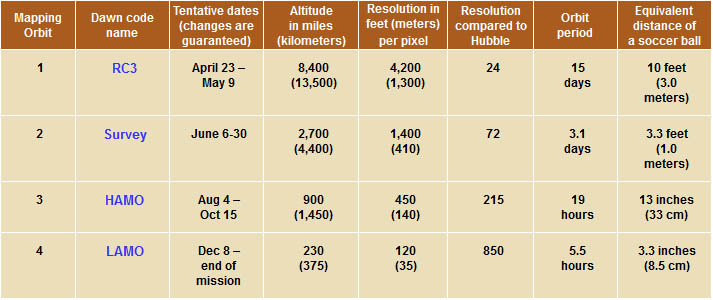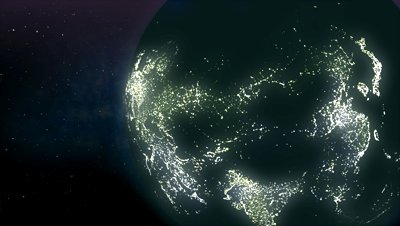It looks like you're using an Ad Blocker.
Please white-list or disable AboveTopSecret.com in your ad-blocking tool.
Thank you.
Some features of ATS will be disabled while you continue to use an ad-blocker.
share:
Latest information from the orbiting satellite shows that there aren't just two "bright spots" but rather TONS of them! So while we were wrong, the
mystery is still out there and gets even deeper than we thought initially!
Link: io9.com...
And further clarification from the source, JPL: www.jpl.nasa.gov...
Link: io9.com...
And further clarification from the source, JPL: www.jpl.nasa.gov...
Of course, even though we now know how, the question of what it is — ice? space volcanoes? thousands of little Ceres roverbots outfitted in their own tinfoil hats? (NOTE: it is not that last one) — still remains. Until our next closest look, at least.
Quote form the link on the OP...
Ummmm, why not tinfoil hats? Or anything else as bizzarre?
How closed minded a blogger are you who seems interested in space?!
NASA. No imagination...taking the excitement out of space exploration.
originally posted by: FamCore
Any probes set to head that way in the next decade or two?
Don't think I'll be holding my breath.. interesting find nonetheless.
No new probes are set to go to ceres, but Dawn is very far from done with Ceres.
Dawn's current orbit (actually the orbital period that just ended on May 9) from which those first images were taken was from a relatively high altitude of 8400 miles. Dawn will continue spiraling lower and lower over the next several months, and will eventually settle into a new permanent orbit of 230 miles in December, 2015.
That orbit will be about 40 times closer than the current orbit, and the images and other data gathered will be about 40 times higher resolution at that time.
So there is a lot of science left for Dawn to do at Ceres. I bet we will discern an explanation for the various bright spots on Ceres over the next few months to a year (actually, maybe "explanations" may be more accurate, since it seems that their may be different kinds of bright spots produced in different ways).


Source:
Dawn Journal - March 31, 2015
edit on 5/11/2015 by Soylent Green Is People because: (no reason given)
It would be so cool to find that the bright spots were light pollution from alien metropolises
a reply to: Soylent Green Is People
Thanks for the info Soylent, but if we're calling a spade a spade here, you, me and 99% of this website knows full well that if those bright spots are anything other than naturally occurring phenomena like ice geysers, frozen CO2 or just very reflective rocks...we'd never hear about it, and certainly not from NASA on anything approaching an official announcement.
SO really, the closer the probe gets and starts to send the hires images, is probably when we are told it's ice.
Thanks for the info Soylent, but if we're calling a spade a spade here, you, me and 99% of this website knows full well that if those bright spots are anything other than naturally occurring phenomena like ice geysers, frozen CO2 or just very reflective rocks...we'd never hear about it, and certainly not from NASA on anything approaching an official announcement.
SO really, the closer the probe gets and starts to send the hires images, is probably when we are told it's ice.
originally posted by: MysterX
a reply to: Soylent Green Is People
Thanks for the info Soylent, but if we're calling a spade a spade here, you, me and 99% of this website knows full well that if those bright spots are anything other than naturally occurring phenomena like ice geysers, frozen CO2 or just very reflective rocks...we'd never hear about it, and certainly not from NASA on anything approaching an official announcement.
SO really, the closer the probe gets and starts to send the hires images, is probably when we are told it's ice.
And maybe it IS ice (geysers, mineral deposits, etc).
a reply to: jaffo
Having had the misfortune of falling down a set of brick patio steps and dislocating my shoulder a couple months ago, I can personally attest that ice is not always reflective, but I have to say that's what this looks like. It's pretty, whatever it is...mesmerizing.
Having had the misfortune of falling down a set of brick patio steps and dislocating my shoulder a couple months ago, I can personally attest that ice is not always reflective, but I have to say that's what this looks like. It's pretty, whatever it is...mesmerizing.
originally posted by: abeverage
originally posted by: Answer
The sources are reflective not luminous.
Unless they are metallic they are most likely a form of Ice. Now if they prove not to be ice that would be interesting!
In this paragraph, NASA is saying the source is not known,
"In this closest-yet view, the brightest spots within a crater in the northern hemisphere are revealed to be composed of many smaller spots. However, their exact nature remains unknown."
Elsewhere they say 'possibly' ice. It Doesn't sound very convincing at all, considering the number of different ideas that was given back a bit. It seems more like everything is now discounted except for ice, but it doesn't really fit the bill either.
A reflective, and light-colored surface, like ice, should register as colder than its surroundings. It would reflect more and absorb less solar energy
than dark surfaces; basic physics. We're told that the bright spots are, in fact, the same temperature as their darker surroundings.
a reply to: 0zzymand0s
Was thinking the same, actually...how much ice resembles diamonds. Would be pretty cool if that's what it really is.
My first thought is it looks like diamonds.
Was thinking the same, actually...how much ice resembles diamonds. Would be pretty cool if that's what it really is.
originally posted by: tigertatzen
a reply to: smurfy
It seems more like everything is now discounted except for ice, but it doesn't really fit the bill either.
Can you elaborate on that?
Well, put it this way, back in early March this is what deputy project scientist Dr Carol Raymond said,
"These spots were extremely surprising and they have been puzzling to everyone who has seen them," the Nasa Jet Propulsion Laboratory researcher told reporters.
"They show up in a 92km-wide crater that's about 19 degrees North latitude. The spot in the centre is about twice as bright as the spot on the side of the crater, and as yet it has not been resolved, meaning it is smaller than the 4km pixel size [of the images].
"But its apparent brightness is already off-scale; it's consistent with high reflective materials."
Now, a deal nearer, they still don't know, except 'possibly' ice, and with the spot* in the centre of the crater, they have something that is very bright, yet also very small, smaller than the actual image of the light seen then.
* I should have said what are now spots in the centre of the crater.
edit on 11-5-2015 by smurfy because: Text.
originally posted by: smurfy
...It seems more like everything is now discounted except for ice, but it doesn't really fit the bill either.
Has the "deposits of mineral salts" hypothesis been discounted? I know one of the earlier hypotheses was that these were white-colored/reflective deposits of mineral salts.
It seems to me that these salts could have been deposited by mineral-rich water percolating up from beneath the surface. Maybe much of that water sublimates into space, leaving the salt deposits behind. Maybe it's even possible that the water is at such a high mineral content/high salinity that it prohibits some of that water ice from sublimating so easily, leaving behind a mixture of highly reflective salty ice (or maybe we should call it icy salt, depending on the mineral-to-ice ratio).
Or, possibly all of the surface water-ice has been sublimated away, leaving only the mineral salts, which could be crystalline and reflective.
edit on 5/11/2015 by Soylent Green Is People because: (no reason given)
originally posted by: Soylent Green Is People
originally posted by: smurfy
...It seems more like everything is now discounted except for ice, but it doesn't really fit the bill either.
Has the "deposits of mineral salts" hypothesis been discounted? I know one of the earlier hypotheses was that these were white-colored/reflective deposits of mineral salts.
It seems to me that these salts could have been deposited by mineral-rich water percolating up from beneath the surface. Maybe much of that water sublimates into space, leaving the salt deposits behind. Maybe it's even possible that the water is at such a high mineral content/high salinity that it prohibits some of that water ice from sublimating so easily, leaving behind a mixture of highly reflective salty ice (or maybe we should call it icy salt, depending on the mineral-to-ice ratio).
I don't know, and that's my point, it's like everyone has gone silent except for, 'exact nature not known' and 'possibly' ice. 'Deposits of mineral salts' was a hot contender at the start, another was exposure of some kind of reflective material after a collision took part of the surface of Ceres away, as was ice.
edit on 11-5-2015 by smurfy because: Text.
new topics
-
Are you ready for the return of Jesus Christ? Have you been cleansed by His blood?
Religion, Faith, And Theology: 1 hours ago -
Chronological time line of open source information
History: 2 hours ago -
A man of the people
Diseases and Pandemics: 3 hours ago -
Ramblings on DNA, blood, and Spirit.
Philosophy and Metaphysics: 4 hours ago -
4 plans of US elites to defeat Russia
New World Order: 5 hours ago -
Thousands Of Young Ukrainian Men Trying To Flee The Country To Avoid Conscription And The War
Other Current Events: 9 hours ago -
12 jurors selected in Trump criminal trial
US Political Madness: 11 hours ago -
Iran launches Retalliation Strike 4.18.24
World War Three: 11 hours ago
top topics
-
Israeli Missile Strikes in Iran, Explosions in Syria + Iraq
World War Three: 12 hours ago, 17 flags -
Iran launches Retalliation Strike 4.18.24
World War Three: 11 hours ago, 6 flags -
Thousands Of Young Ukrainian Men Trying To Flee The Country To Avoid Conscription And The War
Other Current Events: 9 hours ago, 6 flags -
12 jurors selected in Trump criminal trial
US Political Madness: 11 hours ago, 4 flags -
4 plans of US elites to defeat Russia
New World Order: 5 hours ago, 2 flags -
A man of the people
Diseases and Pandemics: 3 hours ago, 2 flags -
Chronological time line of open source information
History: 2 hours ago, 2 flags -
Ramblings on DNA, blood, and Spirit.
Philosophy and Metaphysics: 4 hours ago, 1 flags -
Are you ready for the return of Jesus Christ? Have you been cleansed by His blood?
Religion, Faith, And Theology: 1 hours ago, 0 flags
active topics
-
Two Serious Crimes Committed by President JOE BIDEN that are Easy to Impeach Him For.
US Political Madness • 17 • : TheSemiskepticII -
Israeli Missile Strikes in Iran, Explosions in Syria + Iraq
World War Three • 63 • : CarlLaFong -
12 jurors selected in Trump criminal trial
US Political Madness • 33 • : Myhandle -
Biden--My Uncle Was Eaten By Cannibals
US Political Madness • 49 • : iaylyan -
Thousands Of Young Ukrainian Men Trying To Flee The Country To Avoid Conscription And The War
Other Current Events • 11 • : Consvoli -
"We're All Hamas" Heard at Columbia University Protests
Social Issues and Civil Unrest • 130 • : ImagoDei -
European court rules human rights violated by climate inaction
Fragile Earth • 61 • : iaylyan -
Post A Funny (T&C Friendly) Pic Part IV: The LOL awakens!
General Chit Chat • 7124 • : underpass61 -
Are you ready for the return of Jesus Christ? Have you been cleansed by His blood?
Religion, Faith, And Theology • 5 • : Hakaiju -
4 plans of US elites to defeat Russia
New World Order • 25 • : FlyersFan

